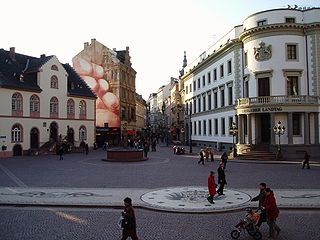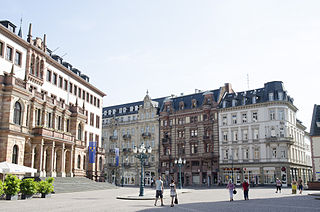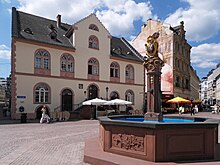Palace Square (Wiesbaden)

The Schlossplatz forms the center of the historic old town within the historic pentagon of the Hessian state capital Wiesbaden . It is surrounded by the former city palace of the Nassau dukes , the old town hall, the new town hall and the market church . In the middle is the market fountain from 1753. Due to this unique building ensemble and the fact that the nucleus of medieval Wiesbaden was located here, the square is the most historically important in the city. It is also wrongly called the market square because the market fountain is located here and touches the market street. However, the market square with the market column has been located above the market cellar behind the New Town Hall and the market church on Dern's site since 1902 .
Notation
As a proper name, "Schloßplatz" was initially spelled with " ß " even after the spelling reform . In the meantime, the city administration, the state government and the church write the Schlossplatz with “ss”. The street signs have also been changed.
building
Almost without exception, the Schlossplatz is surrounded by historical buildings. These are to be introduced clockwise below:
City Palace
The north side of the square is dominated by the former city palace of the Nassau dukes, whose preserved historical interior contrasts with its simple exterior. During Wiesbaden's time as a world spa town, Kaiser Wilhelm II used the city palace as a residence during his numerous stays. Today the Hessian Landtag is housed here. The plenary hall from the 1960s in the inner courtyard was demolished in 2004 before the new building of the plenary hall was inaugurated at the same location in 2008.
Kaiser-Wilhelms-Heilanstalt and Kavaliershaus
Both buildings adjoin the right wing of the palace and today belong to the palace complex with the Hessian state parliament. The buildings were badly damaged during the Second World War , only the facades could be restored true to the original. After the war, the Kavaliershaus was adjusted to the height of the city palace and received an additional floor. The Kaiser-Wilhelms-Heilanstalt, today only called Wilhelmsbau , was built as a military hospital from 1868 to 1871. The larger than life bust of Kaiser Wilhelm I in the red plastered facade is striking .
Secondary school for girls (destroyed in World War II)
The eastern right-angled end of the Schlossplatz was formed by the secondary school for girls , built in 1897 by Wiesbaden city architect Felix Genzmer . It was destroyed in World War II.
The school was regarded as an outstanding monument of late historicism and - next to the foyer of the Hessian State Theater - as the greatest work of its builder. Its neo-Gothic style cited the Gothic town hall of Bremen and the town hall of Brussels very impressively . The building replaced a dilapidated previous building and completed the rectangular shape of the eastern palace square with its wings arranged at right angles to each other.
The school building was not rebuilt after the Second World War. In its place there is now a green area, including a rose garden in the area enclosed by the two former wings of the building. A new Protestant kindergarten was built next to the Marktkirche in 2005, replacing a previous building.
Market Church

The Evangelical Market Church , built by Carl Boos from 1853 to 1862 , with its 5 towers, of which the 98 m high main tower is the tallest building in the city, was built as Nassau State Cathedral based on the model of Schinkel's Friedrichswerderscher Church in Berlin as the largest brick building in Nassau.
new town hall
On the south side of the palace square, opposite the palace, is the New Town Hall , built by Georg von Hauberisser from 1884 to 1887 . The building was damaged in World War II and restored in a simplified form. The once imposing main gable made of red sandstone, which was about the width of the balcony above the entrance, was omitted.
Old Town Hall
The old town hall (Marktstraße 16) on the west side of the square is also the oldest building in the city and was built between 1609 and 1610 as a Renaissance building with a solid ground floor and a colored half-timbered upper floor with bay windows and high gables. In 1828 all half-timbering was replaced by stone masonry. Today the old town hall is used as a registry office.
Space design
The palace square is divided into two parts. The western part - the Schlossplatz in the narrower sense - was restored in 2004 based on the historical model with its cobblestones , shelves and candelabra .
The eastern part is partly green. This includes the tree-lined square directly in front of the market church with a monument to Duke Wilhelm von Oranien-Nassau , the founder of the Netherlands , as well as the rose garden in the far east.
mosaic
In front of the New Town Hall , on a historical traffic island dating back to 1905, a mosaic is attached, which shows the imperial imperial eagle with the black and white squared coat of arms on the chest, flanked by the provincial coat of arms of Hessen-Nassau and the Wiesbaden city coat of arms. The provincial coat of arms goes back to the year 1866, when Nassau was annexed by Prussia. It shows the Hessian lion, the Nassau lion and the white eagle coat of arms of Frankfurt. The explanatory information boards on the coat of arms island describe the central coat of arms as Prussian, the provincial coat of arms as Nassau.
The traffic island was restored together with the rest of the square in 2004. Donations were collected especially for the mosaic; the names of the donors are immortalized in the stones around the mosaic.
Market fountain
The market fountain has stood between the old town hall and the city palace since 1753 . The octagonal basin made of red Main sandstone is decorated with reliefs. A golden Nassau lion crowns the octagonal well. With his front paws erect, he holds an oval shield with a gold crown. The shield shows the coat of arms of Wiesbaden: three golden lilies on a blue background. The lion's breastplate shows the coat of arms of the House of Nassau. The water is supplied via pipes, as there are no fresh water sources in the "narrow city".
Around 1800 maidservants were still cleaning large vessels and the like in the well or cleaning vegetables and salad, where drinking water was fetched here. Only an ordinance banned the contamination.
In 1901 the fountain was moved, in 1981 the basin was reconstructed with harder sandstone. In 2016 the lion was newly gilded.
The silent one
In 1908 the monument to The Silent in front of the Marktkirche was inaugurated. It depicts Wilhelm von Nassau-Dillenburg "the silent one" , was a gift from Emperor Wilhelm II and is the work of the sculptor Walter Schott .
Celebrations and events
The Rheingau Wine Week takes place on the Schlossplatz and the adjacent Dern'schen area on ten days in August every year (from the second Friday in August to the Sunday after next) . This Wiesbaden wine festival likes to call itself the "longest wine bar in the world" and measured by the number of different winegrowers' stands (97) and the different wines served (over 1000) it is actually the world's largest wine festival.
The annual shooting star market has been taking place there during Advent since 2002 (from Tuesday after the Sunday of the Dead until December 23rd).
Since 1975, the traditional international summer festival, the city festival and the carnival parade are regularly held on the square.
As a central location in front of the Wiesbaden town hall and the Hessian state parliament , the Schlossplatz is also often used for other (including political) events. During demonstrations in the Hessian state capital , the Schlossplatz usually serves as the destination or location of the closing event.
If the space on the Dern'schen site behind the New Town Hall is occupied due to another event, the Wiesbaden weekly market held every Wednesday and Saturday morning will be relocated to Schlossplatz.
literature
- Baedeker Wiesbaden Rheingau. Karl Baedeker GmbH, Ostfildern-Kemnat 2001, ISBN 3-87954-076-4 .
- Gottfried Kiesow: The misunderstood century. Historicism using the example of Wiesbaden. German Foundation for Monument Protection, 2005, ISBN 3-936942-53-6 .
- Peter Schabe: Felix Genzmer - city architect of historicism in Wiesbaden. Historical Commission for Nassau, 1996.
Web links
Coordinates: 50 ° 4 ′ 55 ″ N , 8 ° 14 ′ 29 ″ E





